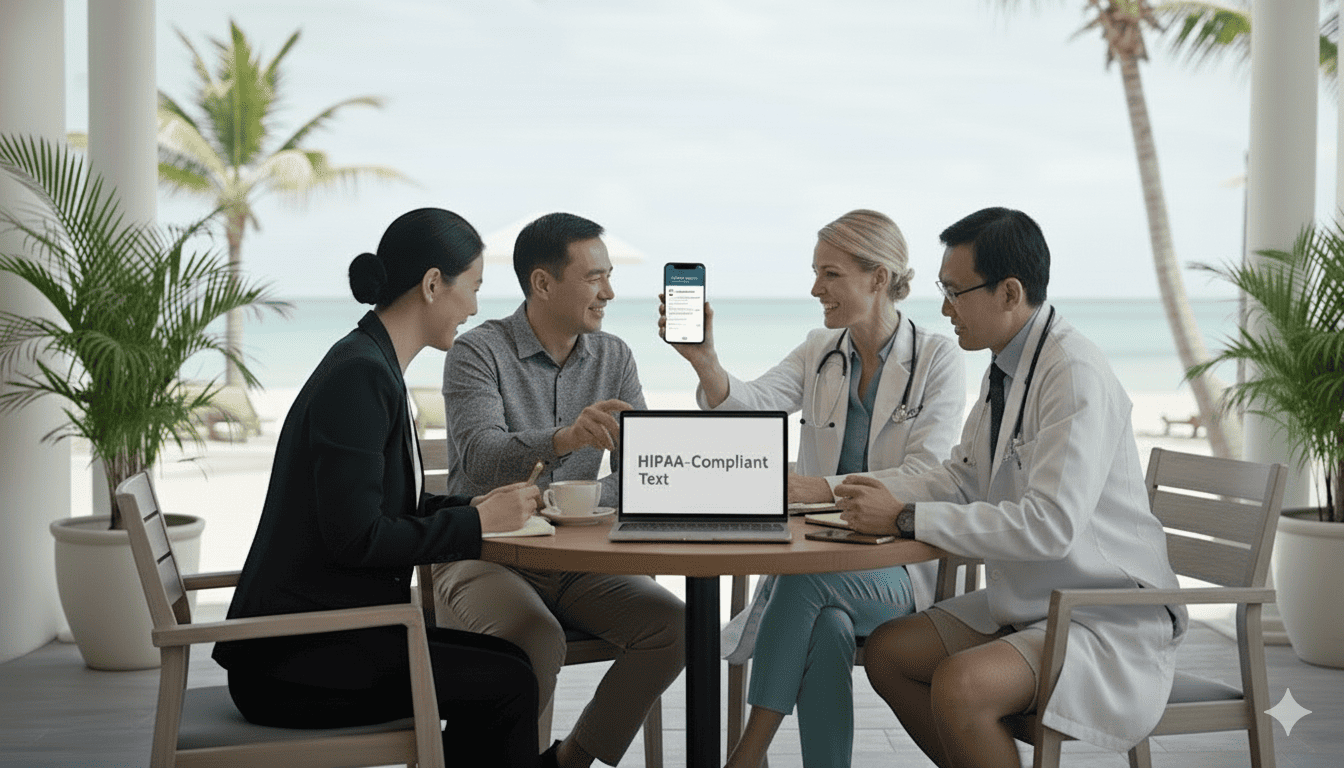Examples of HIPAA-Compliant Texting Workflows in Practice Fusion
💡 HIPAA-compliant texting in Practice Fusion helps small clinics enhance their workflows. With secure texting, they can improve efficiency, reduce...
8 min read
Gregory Vic Dela Cruz : Sep 16, 2025 8:00:00 AM

Phone lines jammed. Patients unsure about prep. Paper forms re-typed into the EMR. For Athenahealth users, the fastest relief is HIPAA-compliant texting. This is a secure, EMR-connected way to reach patients in the channel they actually read and respond to.
Here’s the difference when you add HIPAA-compliant texting Athenahealth workflows. Reminders pull live data from the schedule—time, provider, location. They also include the right instructions for the visit type. Patients confirm with a tap, can reschedule, and complete intake on their phone. Every message and form is encrypted, logged, and filed to the chart. This creates the compliance paper trail your team needs—without more work.
This guide is a complete playbook for secure text messaging on Athenahealth. In this blog, we will:
If your staff feels like “human middleware” between patients and your EMR, it’s time for a reality check.
HIPAA-compliant texting is secure electronic messaging about patient care that protects ePHI with technical, administrative, and organizational controls. In practice, that means encryption (in transit and at rest), access controls, user authentication, message retention, audit logging, and a Business Associate Agreement (BAA) with your messaging vendor—plus policies for identity verification, minimum necessary, and breach response. Platforms designed for Athenahealth also integrate with the medical record so that messages, reminders, and consents are documented automatically.
Standard SMS lacks end-to-end encryption, identity controls, and auditability; messages can live unprotected on personal devices. That’s why regulators emphasize using a secure texting platform when PHI is involved, and ensuring appropriate logging and safeguards for texting orders or patient information. In short, ordinary text threads can’t meet HIPAA requirements without a compliant platform, controls, and a BAA.
With a HIPAA-compliant platform, messages are encrypted, access is role-based, and every action (send, read, escalate) is time-stamped in an audit trail. When paired with Athenahealth, secure messaging can write back encounter-relevant artifacts—confirmations, intake responses, consents—so documentation is complete and consistent across users and locations. The result is the holy grail that healthcare teams want: real-time convenience for patients and airtight records for compliance and continuity of care.
HIPAA-compliant texting for Athenahealth users means using a secure, EMR-aware messaging layer with encryption, logging, and a BAA—not ad-hoc SMS threads. That shift reduces compliance risk while improving response times and data quality in the chart.
Patients are mobile-first. Texting is fast, asynchronous, and private enough for routine logistics. Reviews and meta-analyses consistently show text reminders improve attendance compared to no reminder—and often at lower cost than phone calls. When reminders include accurate details and the ability to confirm or reschedule, clinics fill more seats with less effort.
Two-way texting shifts routine confirmations, directions, prep questions, and simple reschedules out of the phone queue and into a shared inbox. Teams handle many conversations at once, and messages are self-documenting. Clinics that move to EMR-aware texting typically cut call volume by ~40–50% and reclaim hours daily for higher-value work.
HIPAA-compliant communication Athenahealth requires encryption, audit logs, and secure retention. A compliant platform centralizes all reminders, messages, forms, and payments with time-stamped records—so audits are faster and safer. Instead of staff typing notes after a call, the system records the communication automatically, reducing errors and “paper trail” stress. In parallel, your Athenahealth schedule drives the content and timing of reminders (provider, location, telehealth link, fasting instructions), which reduces no-shows and same-day cancels.
Pairing Athenahealth with HIPAA-compliant texting creates a win-win: a channel patients answer, a workflow staff can manage, and a documentation layer compliance can trust—without extra clicks.
Reminders work best when they pull live data from Athenahealth: date/time, provider, location, visit type, and prep. A HIPAA-compliant platform can automatically send a smart cadence (e.g., 72h / 24h / 2h) and include one-tap Confirm/Reschedule options. Confirmations, cancels, and new times flow back to the schedule so staff aren’t double-booking or chasing voicemails. Evidence shows text reminders consistently increase attendance versus no reminder, while costing less than phone calls. Clinics commonly report double-digit no-show reductions once reminders are EMR-aware.
Specialty visits need prep: fasting, medication holds, driver requirements, or telehealth checks. With EMR integration, your reminder sequence can include pre-visit instructions, a secure link to forms, and even a one-tap device test for video visits. Patients upload IDs and insurance cards via encrypted forms; staff validate and push structured data to the chart. This prevents day-of issues, reduces late cancels, and shortens check-in times.
Most patient questions aren’t urgent—but they’re time-sensitive. After-hours auto-replies can acknowledge messages, share on-call or urgent care guidance, and promise a response by a set SLA. Triage keywords (e.g., “HELP,” “refill,” “billing”) route conversations to the right queue at opening. Follow-ups after visits can reinforce care plans or send post-op tips; for telehealth, send the summary link and next steps. All messages remain in the HIPAA-compliant record, not on personal devices.
Post-visit micro-surveys identify issues early and invite happy patients to share public reviews. Consistent, timely requests raise ratings and search visibility. When the request is triggered by the Athenahealth visit completion, the timing and attribution are accurate. Clinics leveraging this workflow report a rapid increase in 5-star reviews, nurturing a stronger local reputation.
When a patient cancels, the system can automatically text a waitlist or targeted segment (e.g., same provider, same location) with the open slot. Patients reply to claim it; Athenahealth updates instantly. This prevents empty chairs and smooths provider utilization, especially in high-demand clinics.
Clipboards cause bottlenecks and errors. Digital intake links sent at booking and included in reminders let patients complete demographics, histories, consents, and SDoH screens in advance. Photos of insurance cards are captured securely. Staff review, then post to the chart. Results: shorter lines, fewer typos, and cleaner claims—plus a complete audit trail for forms and signatures.
Frictionless payments increase collections and reduce awkward calls. After the visit (or for past-due balances), send a secure payment link. Payments reconcile, and the ledger reflects updates without staff re-typing card data. Text-to-Pay shortens days in A/R and gives patients a private, convenient way to settle balances—on their schedule.
Bulk outreach tied to Athenahealth data (care gaps, chronic conditions, age bands) can drive recalls for AWVs, vaccines, or screenings. Because it’s two-way, patients can ask questions or book from the message. Campaign impact is measurable: delivery, response, conversion to appointments, and kept-visit rates, closing loop from message to encounter.
External texting is only half the story. Secure, role-based internal messaging (front desk ⇄ MA ⇄ provider) about logistics and patient status eliminates hallway handoffs and sticky notes. Consistent handoff communication correlates with fewer adverse events and smoother throughput.
Every message, reminder, form submission, and payment interaction is time-stamped and retained within your compliant platform and linked to the Athenahealth chart. During audits, teams can retrieve threads, consents, and delivery/response logs in seconds—much faster than reconstructing phone notes. This directly addresses the compliance risks of unsecured channels and missing documentation.
Outcome you can expect: fewer no-shows, shorter check-ins, lower phone volume, faster collections, and clearer documentation—sustained by workflows your staff can run in minutes a day.

Text reminders increase attendance across specialties; integrated reminders perform best because details are accurate and actionable. Clinics commonly report 20–30% improvements after moving from generic robocalls to EMR-aware two-way texting.
Patients value speed and clarity. When instructions and links arrive at the right time on the right device, they arrive prepared—and they notice. Satisfaction rises, and post-visit review requests capture that goodwill.
Two-way texting reduces inbound calls and manual re-entry. Front desk teams triage a shared inbox, use templates, and escalate only exceptions. It’s common to cut routine phone traffic by ~50%.
Reliable communication and faster responses earn trust. Add automated, well-timed review requests and you’ll see rating counts climb—boosting local SEO and referrals.
After launching HIPAA-compliant texting tied to Athenahealth, a primary care group shifted confirmations and FAQs to text, halving daily call volume and freeing hours for in-office service.
By texting prep instructions and digital intake links at booking and 48 hours pre-visit, a specialty clinic reduced same-day cancellations and saw on-time starts rise within weeks.
Automated post-visit surveys and review nudges tied to visit completion increased new 5-star reviews month over month, lifting search visibility and new-patient demand.
For clinics using Athenahealth, the real power of HIPAA-compliant texting comes when it is seamlessly integrated into the EMR workflow. Instead of forcing staff to toggle between Athenahealth and third-party apps, Curogram connects directly, creating a single, streamlined system. This integration ensures that appointment reminders, two-way communication, intake forms, and billing updates all flow naturally into Athenahealth without extra work.
With Curogram’s two-way HIPAA-compliant text messaging, Athenahealth users can replace the bulk of daily calls with secure, logged conversations. Patients confirm, cancel, or reschedule appointments with a tap. Questions like “Where should I park?” or “Do I need to fast before my lab?” are resolved in seconds. Because every message is encrypted and permanently audit-logged, compliance risks tied to unsecure channels are eliminated.
No-shows and late cancellations cost clinics thousands each year:. By syncing directly with Athenahealth scheduling, Curogram ensures every reminder is accurate and timely. Smart reminders—sent 72 hours, 24 hours, and 2 hours before the visit—include appointment-specific details like provider name, visit type, location, and prep instructions. If the appointment changes in Athenahealth, the reminder updates automatically.
Disconnected systems are a compliance nightmare. Messages scattered across personal phones, intake forms scanned inconsistently, and billing notes lost in email create audit gaps and HIPAA risks. Curogram eliminates those risks by building compliance into the integration. Every reminder, text, and digital form is encrypted, time-stamped, and logged directly into Athenahealth. This creates a permanent audit trail that satisfies HIPAA and payer requirements.
For Athenahealth users, this integration is a lifeline. It reduces communication problems, cuts administrative delays, prevents costly no-shows, and ensures compliance at every step. The outcome: calmer staff, happier patients, and a stronger bottom line.
HIPAA-compliant texting isn’t merely a safer way to send messages. It’s also a simpler way to run your workflows. When you can pull real-time data from Athenahealth, patients come more prepared while your phones stay quiet. Your documentation also stays audit-ready. This combination reduces no-shows, raises satisfaction, and gives your team hours back.
Contrast that with phone-heavy workflows and paper forms. These traditional workflows mean more voicemails, more re-typing, more errors. Pairing secure texting with Curogram is a gamechanger. You get two-way messaging, smart reminders, digital intake, Text-to-Pay, and permanent audit trails. And all of this, synced seamlessly with your appointment schedules.
Ready to see it in action? See how Curogram saves time, reduces no-shows, and improves patient experience. Schedule a demo today.

💡 HIPAA-compliant texting in Practice Fusion helps small clinics enhance their workflows. With secure texting, they can improve efficiency, reduce...

💡 HIPAA-compliant texting in Konica Minolta Exa improves radiology workflows instantly. It does so by ensuring secure, efficient communication...

💡With HIPAA-compliant texting for AdvancedMD, clinics can modernize communication and protect patient privacy. Outdated phone calls and unsecured...